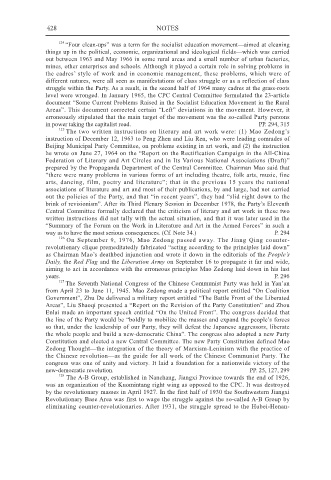Page 430 - SELECTED WORKS OF DENG XIAOPING Volume II
P. 430
428 NOTES
124 “Four clean-ups” was a term for the socialist education movement—aimed at cleaning
things up in the political, economic, organizational and ideological fields—which was carried
out between 1963 and May 1966 in some rural areas and a small number of urban factories,
mines, other enterprises and schools. Although it played a certain role in solving problems in
the cadres’ style of work and in economic management, these problems, which were of
different natures, were all seen as manifestations of class struggle or as a reflection of class
struggle within the Party. As a result, in the second half of 1964 many cadres at the grass-roots
level were wronged. In January 1965, the CPC Central Committee formulated the 23-article
document “Some Current Problems Raised in the Socialist Education Movement in the Rural
Areas”. This document corrected certain “Left” deviations in the movement. However, it
erroneously stipulated that the main target of the movement was the so-called Party persons
in power taking the capitalist road. PP. 294, 315
125 The two written instructions on literary and art work were: (1) Mao Zedong’s
instruction of December 12, 1963 to Peng Zhen and Liu Ren, who were leading comrades of
Beijing Municipal Party Committee, on problems existing in art work, and (2) the instruction
he wrote on June 27, 1964 on the “Report on the Rectification Campaign in the All-China
Federation of Literary and Art Circles and in Its Various National Associations (Draft)”
prepared by the Propaganda Department of the Central Committee. Chairman Mao said that
“there were many problems in various forms of art including theatre, folk arts, music, fine
arts, dancing, film, poetry and literature”; that in the previous 15 years the national
associations of literature and art and most of their publications, by and large, had not carried
out the policies of the Party, and that “in recent years”, they had “slid right down to the
brink of revisionism”. After its Third Plenary Session in December 1978, the Party’s Eleventh
Central Committee formally declared that the criticism of literary and art work in these two
written instructions did not tally with the actual situation, and that it was later used in the
“Summary of the Forum on the Work in Literature and Art in the Armed Forces” in such a
way as to have the most serious consequences. (Cf. Note 34.) P. 294
126 On September 9, 1976, Mao Zedong passed away. The Jiang Qing counter-
revolutionary clique premeditatedly fabricated “acting according to the principles laid down”
as Chairman Mao’s deathbed injunction and wrote it down in the editorials of the People’s
Daily, the Red Flag and the Liberation Army on September 16 to propagate it far and wide,
aiming to act in accordance with the erroneous principles Mao Zedong laid down in his last
years. P. 296
127 The Seventh National Congress of the Chinese Communist Party was held in Yan’an
from April 23 to June 11, 1945. Mao Zedong made a political report entitled “On Coalition
Government”, Zhu De delivered a military report entitled “The Battle Front of the Liberated
Areas”, Liu Shaoqi presented a “Report on the Revision of the Party Constitution” and Zhou
Enlai made an important speech entitled “On the United Front”. The congress decided that
the line of the Party would be “boldly to mobilize the masses and expand the people’s forces
so that, under the leadership of our Party, they will defeat the Japanese aggressors, liberate
the whole people and build a new-democratic China”. The congress also adopted a new Party
Constitution and elected a new Central Committee. The new Party Constitution defined Mao
Zedong Thought—the integration of the theory of Marxism-Leninism with the practice of
the Chinese revolution—as the guide for all work of the Chinese Communist Party. The
congress was one of unity and victory. It laid a foundation for a nationwide victory of the
new-democratic revolution. PP. 25, 127, 299
128 The A-B Group, established in Nanchang, Jiangxi Province towards the end of 1926,
was an organization of the Kuomintang right wing as opposed to the CPC. It was destroyed
by the revolutionary masses in April 1927. In the first half of 1930 the Southwestern Jiangxi
Revolutionary Base Area was first to wage the struggle against the so-called A-B Group by
eliminating counter-revolutionaries. After 1931, the struggle spread to the Hubei-Henan-

